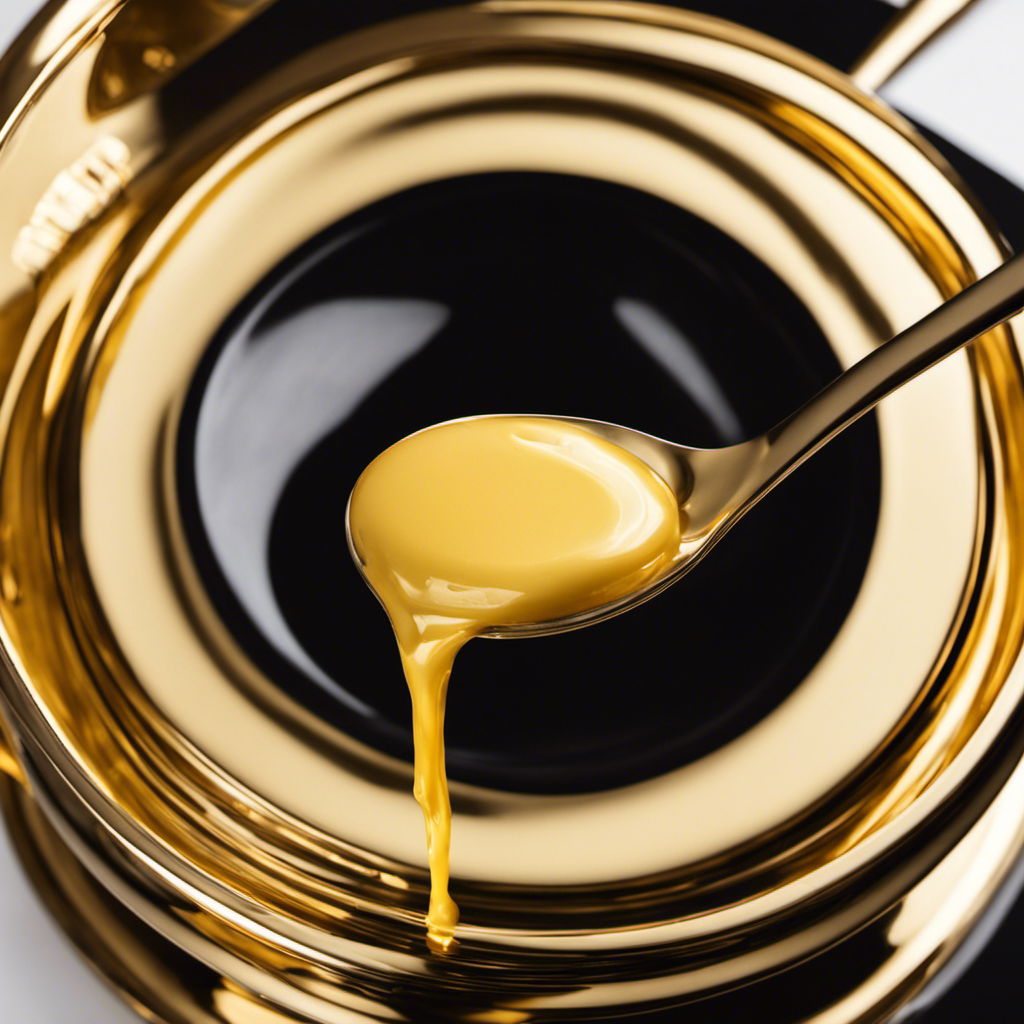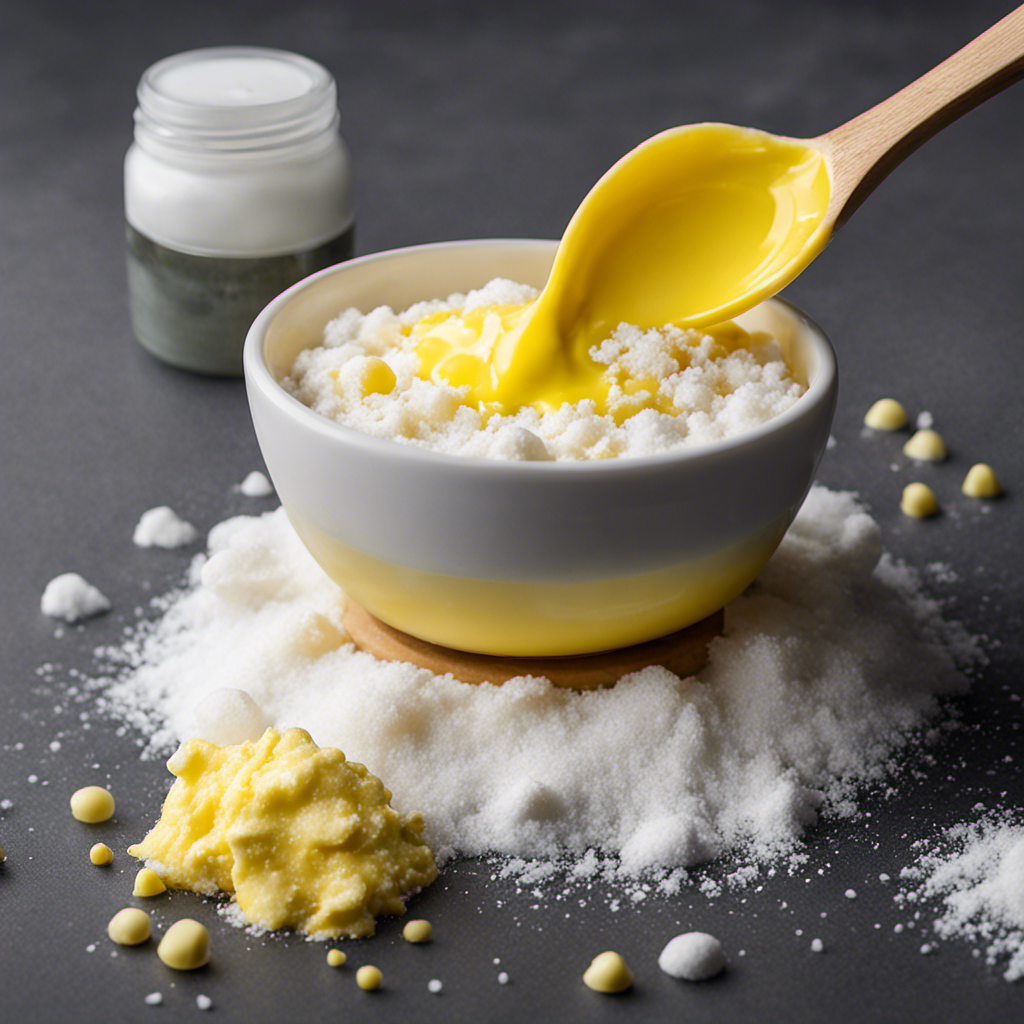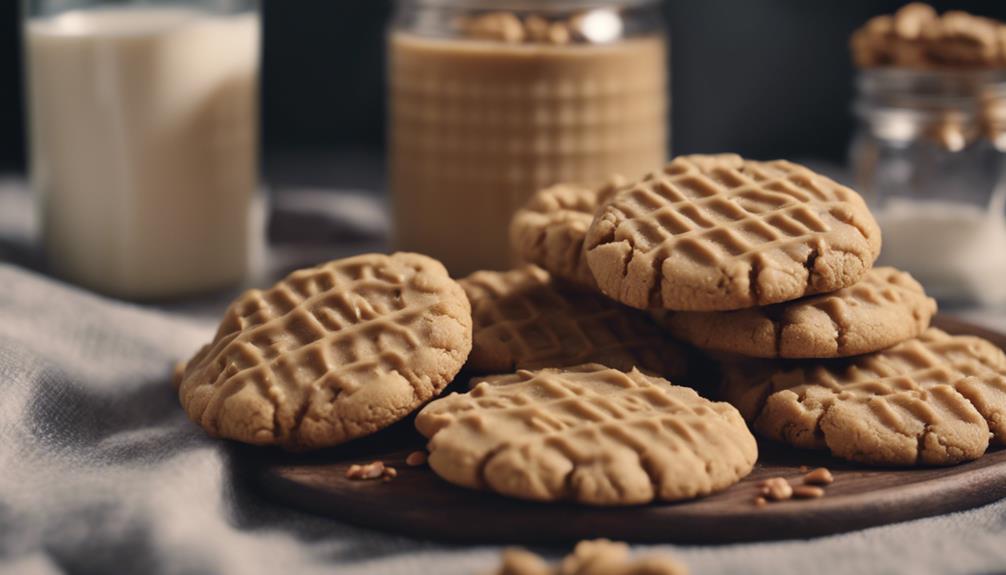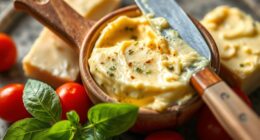As a cooking enthusiast, I have frequently pondered about how to utilize the remaining milk solids from clarified butter. But now, you no longer have to wonder!
In this article, I will share with you a plethora of creative and delicious uses for these versatile milk solids. From enhancing the flavors of savory dishes to baking mouthwatering treats, you’ll discover how to make the most of this often overlooked ingredient.
Get ready to whip up some culinary magic with milk solids!
Key Takeaways
- Milk solids from clarified butter can be used in both sweet and savory dishes to add richness and depth of flavor.
- Incorporating milk solids into homemade ghee recipes can enhance the taste and texture of traditional Indian desserts.
- Milk solids can be used to create creamy and indulgent treats such as ice cream, custards, and pastries.
- The versatility of milk solids allows for creative uses such as infusing spirits and creating creamy mixers for cocktails.
Baking With Milk Solids
I love baking with the milk solids from clarified butter because they add a rich and creamy flavor to my recipes. But did you know that milk solids can also enhance the taste of your coffee?
When added to a cup of coffee, the milk solids infuse a velvety smoothness that balances out the bitterness of the coffee beans. Additionally, milk solids have been found to have moisturizing and nourishing properties for the skin.
In skincare products, these milk solids provide hydration, leaving the skin soft and supple. They also contain proteins and vitamins that can help improve the overall health and appearance of the skin.
Enhancing Savory Dishes With Milk Solids
Using the leftover byproduct from my homemade clarified butter, I can enhance savory dishes with the rich and flavorful milk solids.
Milk solids, which are the proteins and sugars that remain after the butter has been clarified, can add depth and complexity to various culinary creations.
When incorporated into desserts, milk solids contribute a creamy and velvety texture, enhancing the overall taste and mouthfeel.
Additionally, milk solids can be used to thicken and enrich sauces, creating a luscious and indulgent consistency.
By understanding the chemical properties of milk solids and their impact on flavor and texture, I can utilize this versatile ingredient to elevate my savory dishes to new heights.
With this knowledge, I can now explore the possibilities of incorporating milk solids into various homemade ghee recipes.
Homemade Ghee Recipes
After clarifying the butter, I can explore homemade ghee recipes that showcase its rich flavor and versatility.
Ghee, a form of clarified butter popular in Indian cuisine, has many uses beyond cooking. One interesting application is in skincare products. Ghee-based skincare products are known for their moisturizing and nourishing properties. The high fat content in ghee helps to lock in moisture and protect the skin from dryness. Additionally, ghee contains vitamins A, D, E, and K, which are beneficial for skin health.
Another way to use milk solids from clarified butter is in Indian desserts. The milk solids, also known as khoya or mawa, are often used to add richness and depth of flavor to traditional Indian sweets like gulab jamun and kheer. By incorporating these milk solids in desserts, the ghee imparts a unique taste and texture that elevates the dish to a whole new level.
Whipping Up Milk Solid Treats
To whip up delicious treats, I love incorporating the rich and flavorful milk solids from clarified butter in traditional Indian desserts. The milk solids, also known as khoya or mawa, add a creamy and slightly nutty taste to the desserts.
One popular way to use milk solids is by making milk solid candies, such as peda or barfi. These candies are made by cooking the milk solids with sugar and flavorings until they form a fudge-like consistency.
Another creative use for milk solids is incorporating them into ice cream. By adding the milk solids to the base, the ice cream becomes richer and creamier. The milk solids can be mixed with various flavors like cardamom or saffron to create unique and delicious ice cream flavors.
Now that we know how to make milk solid treats, let’s explore some other creative uses for milk solids.
Creative Uses for Milk Solids
When I incorporate milk solids into my recipes, I love experimenting with different flavors and textures to create unique and delicious dishes. Milk solids, which are the protein and fat components of milk, can add a rich and creamy taste to both sweet and savory creations. One innovative way to use milk solids is in desserts. By incorporating them into custards, ice creams, and pastries, you can create indulgent treats with a velvety texture and a subtle hint of dairy goodness. Another exciting application is incorporating milk solids into cocktails. By infusing them into spirits or using them to create creamy mixers, you can add a creamy and luxurious element to your favorite drinks. The possibilities are endless when it comes to exploring the versatility of milk solids in culinary creations.
| Innovative Milk Solid Desserts | Incorporating Milk Solids into Cocktails |
|---|---|
| Custards | Infused Spirits |
| Ice Creams | Creamy Mixers |
| Pastries | |
Frequently Asked Questions
How Long Can Milk Solids From Clarified Butter Be Stored, and What Is the Best Method for Preserving Them?
I store milk solids from clarified butter in an airtight container in the refrigerator. This preserves their freshness and extends their shelf life. It’s important to keep them away from moisture and odors to maintain their quality.
Are Milk Solids From Clarified Butter Safe for Individuals With Lactose Intolerance or Dairy Allergies?
Lactose intolerance and dairy allergies are important considerations when discussing the safety of milk solids from clarified butter. It is crucial to understand the potential risks and consult with a healthcare professional before consuming them.
Can Milk Solids From Clarified Butter Be Used as a Substitute for Other Dairy Products, Such as Cream or Milk, in Recipes?
Milk solids from clarified butter can be used as substitute options for cream or milk in recipes. They add a rich, creamy flavor and can be incorporated using various cooking techniques.
Are There Any Health Benefits Associated With Consuming Milk Solids From Clarified Butter?
Consuming milk solids from clarified butter has potential health benefits due to its nutritional value. Research suggests that these solids may contribute to improved digestion, increased nutrient absorption, and enhanced overall well-being.
Can Milk Solids From Clarified Butter Be Frozen for Long-Term Storage, and if So, What Is the Recommended Freezing Method?
Yes, milk solids from clarified butter can be frozen for long-term storage. The recommended freezing method is to place the milk solids in an airtight container or freezer bag, removing as much air as possible, and then labeling and dating the container before placing it in the freezer.
Conclusion
In conclusion, milk solids from clarified butter can be utilized in various ways to enhance your culinary creations. Whether you’re baking, preparing savory dishes, or making homemade ghee, these milk solids add a rich and creamy flavor.
Additionally, they can be used to whip up delicious treats or incorporated creatively into different recipes. For example, adding milk solids to a traditional chocolate chip cookie recipe can result in a softer and more flavorful cookie experience.









